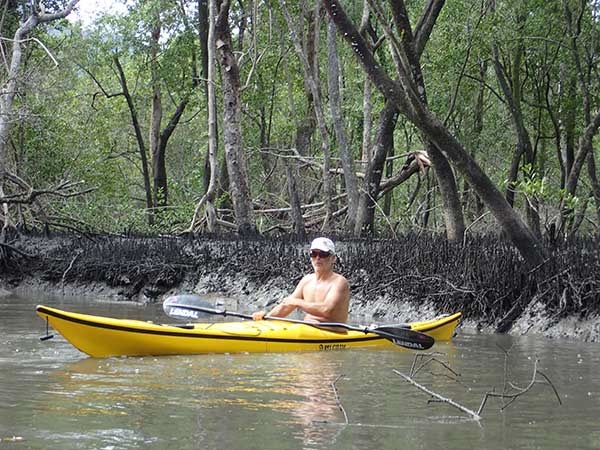Mamangua is for sale!

Caramor - sailing around the world
Franco Ferrero / Kath Mcnulty
Wed 19 Aug 2015 23:57
Saco de Mamangua is often called the 'Brazilian fjord'. Technically it isn't, it is a drowned valley surrounded by mountains. It has two pretty little islands; Ilha Grande (Big Island) and Ilha Pequenha (Small Island). I love the Portuguese imagination when it came to place names! When Michel Balette, the author of our cruising guide to Brazil visited Saco de Mamangua, there was only a small village and isolated houses. A few people had generators, everyone else went to bed when it got dark. Very few boats called by and the villagers welcomed passing sailors with open arms.
Just a few years later, the valley has been electrified and all is changed. As we sailed in we were surprised to see many new holiday homes and hotels at the top end, most blending into the shoreside trees all the way down to the village. We dropped anchor behind Ilha Pequenha in perfectly calm water and admired the setting sun blushing the summit of the surrounding hills.
Ilha Pequenha
Electricity is a recent event, the pylons are brand new and the swathe cleared for the installation is still fresh. The head of the inlet hasn't been developed yet, the water isn't clear and the tide goes out leaving large areas of mud (and mosquitoes). Although less desirable, it is all for sale though, either from the people who live there or from land speculators who bought land before the area became popular.
Mamangua - all the coast line in this photo is for sale
Robusta, the Swiss boat we met on Ilha Grande had suggested we meet up in Mamangua to go up the river to the waterfall together. Monday they had said. As we had weighed anchor, they shouted over "... or Tuesday."
Fine we had plenty to do but by Wednesday we decided they were probably not coming so we clipped the kayaks together and headed off. We entered the river half way on a rising tide but there was very little water ... and lots and lots of mosquitoes. We had gone less than 200m and our passage was blocked by a large tree that had fallen right across the channel. We turned around and sprinted for the open with a cloud of mozzies hot on our tails. It hadn't rained for over six weeks and judging by the flow in the river, the waterfall wouldn't be very impressive.
Franco 'running' from mosquitoes
Instead, we paddled to the top end of Mamangua gleaning architectural ideas for the renovation of Tan y Coed Uchaf. Franco particularly liked a small holiday house built on a boulder. We swam in clear water, a privilege we are particularly making the most of in anticipation of heading to the far south. On the way back we stopped for a drink at the only place open for business. A young pig was running around behaving like a dog, if anyone stroked it, it would roll over and get you to tickle its tummy. A good strategy for survival maybe?
Back in our kayaks the wind had picked up. We had to paddle hard the last couple of kilometres to get back to Caramor. After rounding Ilha Grande, we saw a beautifully done-up pink and purple fishing boat leave the shore and come over to us. The skipper shouted to Franco that the wind was going to blow hard overnight and we should seek a more sheltered anchorage for Caramor. He stayed with us while we paddled back to the boat. He asked how deep our keel was and suggested we park under the Point a little further into Mamangua. We followed his advice and the spot was very sheltered and out of the strong wind gusts. We did a fair bit of ploughing with the anchor in the soft bottom mud before we got it to hold.
By the morning the sun was back and the wind had dropped. We had a lovely sail out of Saco de Mamangua. At the entrance we passed Robusta ... three days late! Whatever happened to Swiss timekeeping? Never mind, we are bound to meet up again as they are also heading south.
Kath


